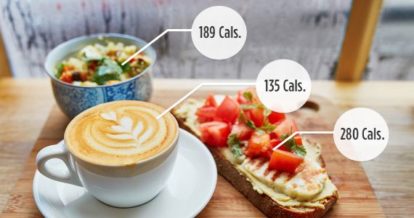In 2017, Ontario became the first Canadian province to require restaurants to highlight calorie counts on menus. This revamp is a part of the Healthy Menu Choices Act which came into effect January 1st, 2017.
Like its U.S. counterpart, the legislation requires any chain restaurant with more than twenty locations to add calorie information to menus in an effort to allow restaurant goers and, particularly, families to make more informed choices about the food they’re putting in their bellies.
While instituted with the best of intentions for the hungry Canadian public, parents, and business transparency, the Act has received its fair share of criticism mainly because:
It’s Costly
Restaurants have had to spend countless dollars updating menus, apps and menu boards, and time on counting every last caloric ingredient. Adhering to the addition of statements and calories adds a lot of text in otherwise already full menus.
It’s Effectiveness Is in Doubt
There’s doubt that food labelling with have any effect on consumer decisions in the long run (except for those who are already healthy eaters.)
It Lacks Alternative Nutritional Information
Calories are only half the story. What about trans fat? Salt? Sugar?
While these grievances are legitimate, they’re negated by the fact that Canada is in the midst of a health crisis: In 2014, obesity rates for adults in Canada were at 20.2%, costing the healthcare system $4.5 billion annually.
As executive director of the Ontario branch of the Heart and Stroke Foundation, Joe Belfontaine said, “Menu labelling is one small thing that empowers parents and empowers Ontarians to take control of the choices that they make when they’re having lunch or dinner at a restaurant. Certainly it’s not the end-all or be-all, but it’s an important tool in the toolbox.”
With all this said, in this article we’ll look at two things: First, the minimum requirements for Ontario’s Healthy Menu Choices Act. Second, we’ll address common concerns of restaurateurs and franchise owners and discuss ways you can transform calorie labeling from a burden into an opportunity.
| Ontario’s Healthy Menu Choices Act | More Info > |
| When does it come into effect? | January 1, 2017 |
| Who does it apply to? | Restaurants and food service providers with more than 20 locations in Ontario |
| Restaurant types affected | All restaurants, fast food joints, movie theatres, supermarkets and convenience stores |
| Alcohol? | Including alcohol |
| What do restaurants have to do?? | Calorie Labeling and Formatting: Restaurants must provide calorie counts for all menu items in the same size and lettering as the price on the menu (including menu boards.) Caloric Statement: According to the law, restaurants must include one of the following statements on their menus. Regular food items and menus: “The average adult requires approximately 2,000 to 2,400 calories per day. However, individual calorie needs may vary.” Food items directed at children: “Adults and youth (ages 13 and older) need an average of 2,000 calories a day, and children (ages 4 to 12) need an average of 1,500 calories a day. However, individual needs vary.” |
| Where must calorie information be found? | On any menu. This means drive-through menus, menu boards, online menus, display, advertisements and promotional flyers. Loophole: According to osler.com, “The Regulations clarify the definition of ‘menu’ by exempting online menus, menu applications, advertisements and promotional flyers if they do not list prices for standard food items, or if they do not list standard food items available for delivery or takeout.” |
| How is caloric content determined? | By either testing in a laboratory or through a nutrient analysis method. |
| Calorie grace period | All menu items have a 20 calorie point grace until January 2018 when the difference will be decreased to 5 or 10. |
| Daily special? | Daily specials only need a calorie count if they’re on the menu for 5 days or longer. |
| Penalties | Fines range from $500 to $1,000 a day for individuals such as franchisees, and $5,000 to $10,000 a day for corporations. 1st offence: $1,500 2nd offence: $5,000 3rd offence: Restaurant operations suspended for a period of time. |
Now that we’ve covered the basics of Ontario Healthy Menu Choices Act, let’s look at some ways that we can use the act to your advantage.
From Concern to Opportunity
Concern: A few of my menu items have very high calorie counts. I want to cut down some of those calories. How can I do this without compromising the taste of the meal?
Opportunity: It may come as no surprise that your best seller might also tally an enormous calorie count. Butter makes things better right? An easy way to shed a few calories from your menu counts is to substitute calorie heavy ingredients with lower calorie substitutions.
For example:
Unsweetened applesauce: In baking, applesauce is a low calorie binding and sweetening agent and can act as a stand in for vegetable oil, butter, sugar and even eggs.
Add vegetables: Cauliflower and mushrooms are filling, texture satisfying and low calorie alternatives to large portions of meat. You can also cut down on wheaty calorie-heavy noodles by adding in more vegetables. Vegetables are the perfect sneaky ingredient and ensure your guests will leave feeling satisfied, without the calorie burden.
Cut the cream: While low fat dairy has many calorie advantages, often it’s just too thin. Using evaporated milk and half-and-half in place of heavy cream can eliminate up to 50% of the calories but retain an acceptable viscosity. While you’re at it, using 2% or 1% milk over whole milk is a simple way to cut calories as well. Other low fat dairy alternatives include low fat cottage cheese over calorie heavy ricotta.
Yogurt: Fajitas just aren’t fajitas without the salsa, guac, sour cream accoutrements. (But, no one in their right mind would axe the guacamole!) Instead plain nonfat Greek yogurt is the perfect low calorie replacer for sour cream. Even full fat Greek yogurt has less calories than low fat sour cream, with Greek yogurt coming in at 300 calories per cup next to reduced fat sour cream at 416 calories. Replace it in a sauce and you can hardly taste the difference.
While all these substitutions are great, sometimes lowering the calorie count might be as simple as using one spoonful of butter instead of three.
Concern: The cost of re-designing and engineering my menu is large. How can I cut down on costs?
Opportunity: Unless you have a digital menu board, whatever way you slice it, updating your menus is a costly endeavour. The cost of a menu board can be anywhere from $800 to $5,000. Then multiply that by at least twenty and you’re footing a hefty bill. But hello silver lining: this is also an opportunity for restaurant chains to embrace the future and the technology that will empower all menu changes from here on out. Those who have digital menu boards are laughing… (well, maybe giggling) because they’re not feeling the cost effects of the Act as severely. While digital menu boards are more costly up front, they’re a worthy investment if your chain frequently changes its menus. Not only are they updated with a click when you need to switch from lunch to dinner, but all around, they’re more convenient and could actually make you money: they never forget to upsell by displaying priced add-ons to customers.
Beyond the menu board, it’s also a great time to think about how sit down menus are designed and altered. Using a menu software allows you to keep costs in house saving you valuable time, effort and cash. When fired out to a third party design firm, you’ll endure lengthy approval processes, bottlenecks, back and forth and a cast for every adjustment.
Concern: My menu is healthy but because nuts and oils are high in calories I’m afraid it won’t sit well with calorie conscious customers.
Opportunity: Olive oil, avocado, coconut: health foods with high calorie consequences. As food creators, we know that while these foods might be high on the calorie richter scale, they’re nutrient dense and packed with good fats, proteins and minerals. They sustain the feeling of fullness and squash cravings that would have us craving empty calories and sugars. We know this. But not everyone does. The purpose of this legislation, at its core, is a mix of education and transparency. Why not embrace this? Instead of just putting calorie information on menus, educate your customer.
Did you know that avocado contains more potassium than bananas? Or that cashews lower your risk of cardiovascular and coronary heart disease? Or that chia seeds contain more Omega-3s than salmon? While these all add up to a higher calorie count, your body absorbs the nutrients in an entirely different way than it does a cinnamon bun. Through education and transparency about why you’ve chosen the ingredients you have, high calorie counts have substantially less weight.
While the Healthy Menu Choices Act might feel burdensome, nannying or incomplete, what it has successfully done is created a conversation around health and nutrition, for both customers and restaurants.
For customers, cheat day will always be cheat day. But for restaurants, we’re now more conscious of the ingredients we’re putting into our dishes, and thus, are placing the health of our customers first.
While we can’t be sure whether other Canadian provinces will follow suit, with the US instituting similar laws, we can bet that nutritional transparency will be at the forefront of industry discussions in the coming years.
Download our free inventory template
Sign up for our free weekly TouchBistro Newsletter







